Part 1
Part 2
Part 3
Part 4
Part 5
Today we have the guest blog from reader Hank, who goes by the handle Vana2. He shows us the building of that gorgeous curly maple stock for my new Benjamin 397. I hadn’t planned on publishing this so soon, but the stock is so beautiful that I just couldn’t resist.
If you’d like to write a guest post for this blog, please email me at blogger@pyramydair.com.
Take it away, Hank.
Benjamin 397 – A Tale of Two Stocks
This report covers:
- The curly maple stock
- Varnish drying jig
- The laminated birch stock
- Summary
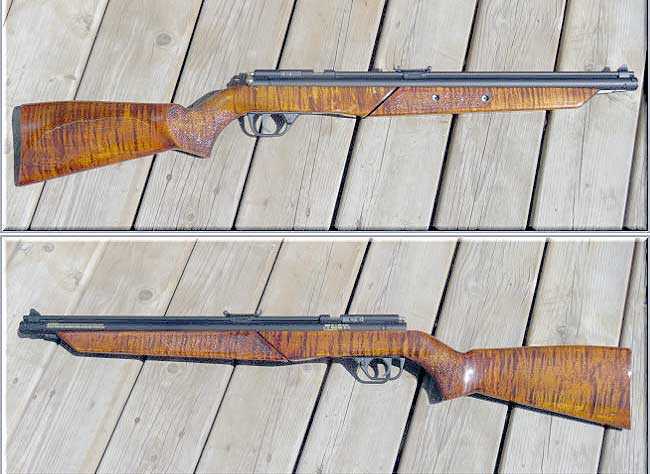
The Benjamin 392 in curly maple.
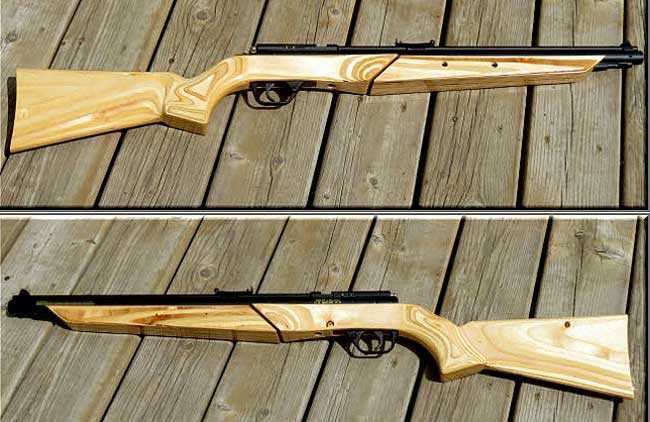
The Benjamin 392 in laminated birch.
A Slavia 618 break-barrel was the airgun I learned to shoot with but it was my Crosman 101 that really got me into shooting and hunting. Being a .22 caliber “pumper,” it has some serious power — plenty for small game hunting!
Since I like multi-pump pneumatics, it’s not surprising that I took a special interest in this Benjamin 397 series. But I never anticipated how interesting it would become.
It started innocently enough — we were discussing the issue with the synthetic stock comb being too high for iron sights and RidgeRunner suggested that he might be interested in a wood stock for the Benjamin. Teasing, I suggested that if he would buy me a Benjamin 392 I would make us both a wood stock. Well, RidgeRunner knew I was pulling his leg and declined — what I didn’t expect was an email from B.B. saying that he would like to take me up on that offer. Long story short, two weeks later a Benjamin 392 (.22 caliber) was delivered and I got down to making some stocks.
Initially, I was going to make a pair of firewood-style stocks but in looking things over it was not a practical approach. With the way the trigger-block and the pump-arm are designed I felt that the stresses would be higher than the thin sections of cross-grain wood would be able to handle. So the options were for a standard construction stock or a laminated stock.
In checking my materials I found a curly maple blank and some odds and sods pieces of birch plywood in the wood bin – which worked out perfectly, since I needed to make two stocks.

Here are some close-ups of the stocks to show a bit more detail.
Both the curly maple and the laminated birch stocks are very difficult to show off in a still photograph, you really need a video to appreciate how the highlights move in the wood as they follow the light.
The Curly Maple Stock
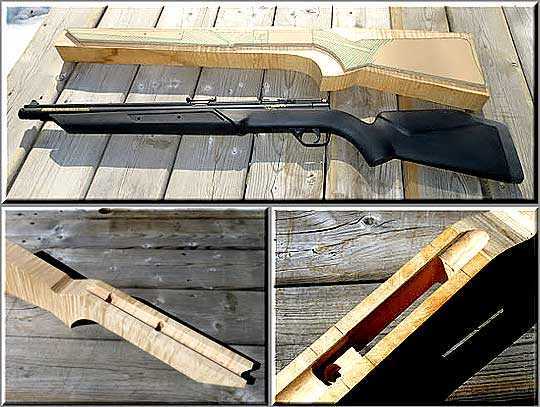 /product/benjamin-variable-pump-air-rifle-black?m=4869&swcfpc=1
/product/benjamin-variable-pump-air-rifle-black?m=4869&swcfpc=1
The top image shows the maple blank with the cardboard template and the Benjamin 392 with the factory synthetic stock. The bottom images show details of the inletting for the receiver.
The curly maple stock was made in the traditional way — start with a hunk of wood and carve away all the wood that doesn’t look like a stock. This “subtractive” approach is sometimes referred to as “hogging it out of a solid”.
The stock construction is straightforward. Do a layout on cardboard to review all the important features and cut it out to use as a template; transfer the outline to the material and cut out the stock profile; inlet the stock for the pump-tube and trigger-block; shape the stock to its final dimensions then sand and finish to suit. The images above show the first couple of steps in the construction, the ones below show the rough stock fitted to the action and the shaped stock ready for final sanding and finishing.
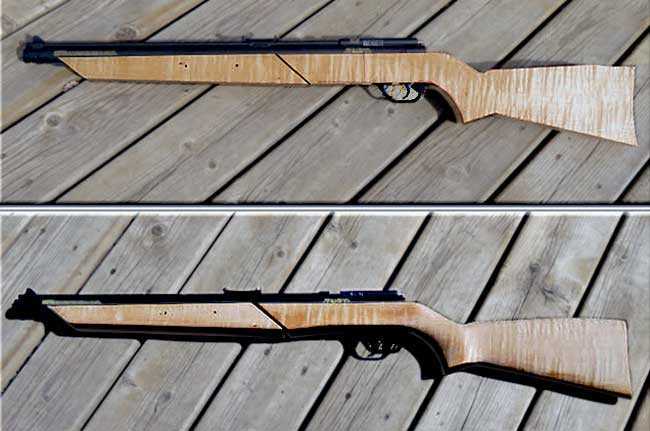
Here is the action mounted in the rough stock (top) ready for shaping and the finished stock (bottom) ready for final sanding.
Varnish drying jig
This is one of those kind of projects that always gets put off and when you finally get around to making one you wish that you had done so years ago. I thought that I would show-off my fancy drying jig. The best way to avoid runs and drips is to (constantly) rotate the stock while the finish sets up. I made my jig from some scraps of wood, a piece of threaded rod that turns in bearings, some hardware and a BBQ rotisserie motor. It took about an hour to put together.
To continue with the finishing, the sanded stock was “stained” with Aqua-Fortis [ED: nitric acid] and coated with high gloss polyurethane. Aqua-Fortis is a reagent that works particularly well with curly maple — it interacts with the sugars in the wood and really makes the grain “pop”! Basically, the Aqua-Fortis is applied to the wood, allowed to soak in and then “blushed” with the application of heat. When the desired finish is achieved, the Aqua-Fortis is neutralized and the stock washed before it is left to dry thoroughly.
The next thing is to apply a protective finish. Before applying the polyurethane the stock is sanded lightly to remove and raised “whiskers” of wood grain then cleaned with alcohol or naphtha. Several coats of thinned polyurethane are applied followed by several “build coats” of regular viscosity polyurethane with sanding and cleaning done between each coat. The instructions say that you can re-coat after several hours but I prefer let the polyurethane dry for (at least) 24 hours between coats to avoid trapping solvents between the layers.
Note: I stippled the pump-arm and hand grip just before applying the final coat of polyurethane. That way the stippling would be sealed but not filled.
I typically use gloss polyurethane and buff the surface with pumice (AKA rotten stone) to a satin sheen but on this stock for the Benjamin 397 I left it at full gloss to show off the grain. The glow in the curly maple shifts and shimmers all over as the light plays over the surface, didn’t want to lose any of that. I figure it is a plinking rifle so shiny is okay.
The laminated birch stock
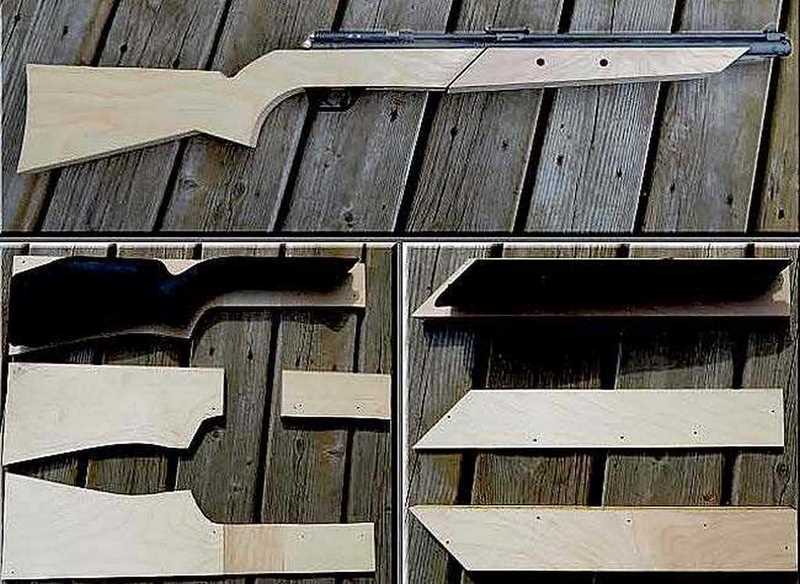
These images show the roughed out birch plywood stock (top) and the pieces (bottom) prepared for making up the blank.
The birch stock blank was assembled by gluing various thickness of plywood together to create the bulk to carve the stock from. Using an additive process to build a stock allows you to add wood only where it is needed saving a lot of rasping later on. The cavity for the trigger-block was created by adjusting the core layer to leave a space in that area. If you look closely, you can see the pinning holes used to align the sides and the core for gluing.
Once the glue is set the rest of the stock construction follows the usual pattern. Transfer the outline to the material and cut out the stock profile. Inlet the stock for the pump-tube. Shape the stock to its final dimensions then sand and finish to suit.
Birch plywood is readily available and makes a nice stock but there are a couple of things to be aware of.
You should test a scrap sample before trying to stain a plywood stock. The laminations in a sheet of plywood alternate, running horizontally and vertically through the material. These changes in grain direction affects stain absorption resulting in very high contrasting stripes in the stock which may or may not be to your liking. I tried several stains and didn’t like the results.
The inner layers of the plywood frequently have “flaws” like knots and such that may be exposed during shaping. I don’t mind these “surprises” as they add a little character to the wood.
Also, because of the thin laminations and the (relative) softness of the wood the surface of the birch plywood does not take checkering or stippling the way a solid wood stock will. It just kind of splinters and falls apart.
All that considered; the birch plywood sands very smooth and shows deep highlights that dance and shimmer under the polyurethane. I don’t usually care for light colored, glossy stocks but I’m quite pleased how this one turned out.
Summary
It seems that the Benjamin 300-series multi-pump rifles have been around since the 1940’s. My friend bought a Model 347 in the late 60’s. The current (version 3) .177 Model 397 and the .22 caliber Model 392 have been available since 1997. Goes to show that they are a good thing!
I am glad to have a Benjamin 392. Iron sights and hand pumping are way different than scopes and PCPs. I’m enjoying the change of pace, smacking tin cans and getting some exercise at the same time… been away from that for too long.
Thanks Tom, hope you enjoy your new stock!
Hank
[Editor’s note: I put this guest blog in today because Hank sent it to me and I was still jazzed about the curly maple stock he made. I’m not trying to ram a Benjamin multi-pump down your throats, but I do want you to see what one does when the stock is shaped more normally.]

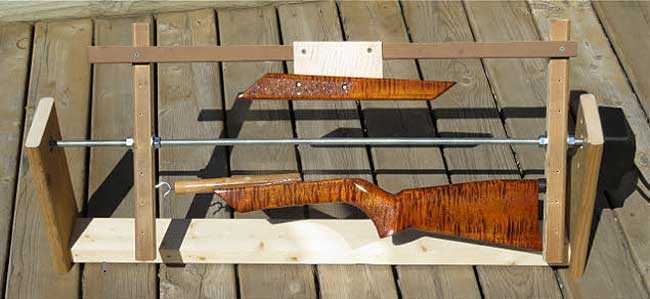
B.B. and Hank,
Thanks for letting us see the process on how you made this Hank. Seeing this makes me want to get one for restocking. But, I’ll be hunting for a FWB 300s over here in the meantime.
Siraniko
You are welcome Siraniko!
Good luck in getting a FWB 300, they are awesome rifles!
Hi, I’m Orv. Although I’ve been reading this blog for a couple of years now, this is my first reply . . . so go gently with me guys. I recently recieved my long awaited for TX200 from Pyramyd. It has the walnut stock as ordered, but to my dismay the finish is matt. Although this walnut is flawless, it certainly doesn’t have the beautiful dark shine portrayed in the ads. OK, so I set out on my own to rectify the situation. I first applied a couple of well rubbed layers of Old English furniture polish. I then polished the wood and metal with Ballistrol. Nice, but not yet what I had hoped for. After reading these blog entries on stock finishing, I thought you might have some advice to help me bring out the luster and maintain my precious Air Arms TX200. I await with polishing rag in hand. Your expert help is eagerly anticipated. Thanks, Orv
Orv,
It is an oil rubbed finish. I had one in .22 in Walnut. In a way, I like it better than a poly gloss top finish. Enjoy it as-is. I would do no more than what you have already done.
I just used Ballistol on mine by the way.
Chris
Orv,
Welcome to the blog! 🙂
I feel confident that in these comments you will find what you need.
BB
Hi Orv!
I cannot speak for others, but I promise to be as gentle as I can with you. Having said that…You want to do what?!
No, I can certainly understand how some prefer their wood to shine, most especially a fine grained piece that I am sure than walnut stock is. I have wanted a TX200 HC with walnut stock since I first learned of them years ago. I myself though am one who prefers the oil rubbed finish. My Webley/Hatsan Tomahawk arrived in a nice oil rubbed Turkish walnut stock. It is going nowhere fast.
Hank could possibly offer you some guidance concerning refinishing that stock. Because of my lack of experience, I dare not.
Hi Orv-
I believe a paste wax top coat will achieve a desirable sheen for you and help protect the gun’s finish. You will need to first remove the contamination on the stock from the Old English (mineral oil, silicone, etc.) and Ballistol. Wipe down the stock with mineral spirits followed by a wipe down with denatured alcohol. Over the years I have used a number of brands of furniture wax on furniture and guns. Butcher’s, Johnson and Minwax are currently on my shelf. There are colored waxes available if you wish to alter the stock color. I think the most important ingredient is good old elbow grease. Anyway, apply the wax, let the solvent evaporate and then buff. Good luck.
Orv,
Welcome to posting on the blog. Hope to hear more from you since you’ve got great taste in airguns.
Yes, you’re right, the TX 200 in walnut typically comes very dry from the factory will a minimal amount of oil on the stock. Based on your post I’m assuming that you want to apply something to the stock that makes the grain in the wood “pop” more, darken the wood a bit and provide a luster/sheen to the finish? If I’m making the correct assumptions then….
1-As you undoubtedly know, there are books written on gunstock finishing. My short answer is no substitute for reading.
2-You’ve started altering the finish on your TX 200 by “layer caking” products that aren’t compatible. Putting Ballistol over Old English furniture polish is a problem. Furniture polishes typically contain petroleum-based products as carriers and also contain silicone. Typically, these furniture polishes don’t completely dry for these reasons and leave a slimy residue like Vaseline. This attracts dirt and dust which overtime results in a dull, dirty finish which is the opposite of what your goal is (and the opposite of furniture polish marketing).
3-I would suggest that you strip off the Ballistol and Old English Furniture polish. Use a 50/50 solution of water and white distilled vinegar. Take the action out of the stock. Use a microfiber rag, dip it in this solution, wring it out, work in the direction of the grain in the wood and dry. Repeat until you get to the original, thin oil finish on your stock.
4-Now you have to decide what type of finish suits you. Do you like the thick polyurethane shell that is found on Weatherby stocks? Do you like a BLO (Boiled Linseed Oil) finish like a Garand? Do you want to control the amount of luster/sheen while making the grain pop in your stock and providing a protective coating that is easy to repair dents and dings when they happen (unlike a poly finish)? You’ve got lots to choose from, BLO, RLO, TruOil, urethane/varethane, linspeed, tung oil, walnut oil, etc. etc. The main difference is the percentage of drying agents added and how easy there are to work with to achieve a decent finish in a gunstock.
5-As I understand your goals, I would recommend TruOil or my preferred product Royal London Oil. These products require multiple coats WITH COMPLETE DRYING OF THE PREVIOUS COAT BEFORE APPLYING THE NEXT in order to build up the finish to the amount of sheen/luster you’re after. If it gets too shiny for your taste you can knock down the finish with rottenstone or a stock conditioner like birchwood casey sells. The biggest mistake people make using these products is using too much which results in runs and imperfections in the stock finish. Use 2-3 drops at a time and spend time rubbing it in. It should only take 12-15 drops to apply one coat to the entire outside of the stock. Before you start the finish on the outside of your stock, remove the action and seal the inletting and screw holes from inside the stock. Plug your screw holes. Put two light coats of the TruOil or Royal London Oil on your inletting and screw holes before starting on the outside of the stock. Get some fine scotchbright pads (buy them in 8 ½” x 11” sheets and cut them into the various size pieces for use on the various areas on the outside of your stock) in order to lightly scuff the surface of your previous coating to not only level the previous coat but allow the scuffed surface to better accept the next coat. Get a bag of microfiber cloths to remove any debris from the stock before applying the next coat. In later coats you will want to use 1000-2000 grit wet sandpaper.
I’m sure there’s lots of youtube videos out there. Go slow.
ps-If you’re going to use any wax on your gunstocks or metal use Renaissance Wax not paste wax. If it’s good enough for firearm museums preserving their irreplaceable arms it’s good enough for us.
Orv, Almost forgot. Mask off your checkering. You don’t want to fill the checkering with any finish product. At most, at the very end, thin your Truoil or RLO with mineral spirits and put a thin coat on the checkering.
Hi Orv, welcome to the blog!
As mentioned, the TX200 walnut stock comes from the factory with a basic oil finish. I say “basic” because it is a quick finish that protects the wood. At traditional (linseed) oil finish takes many, many oil/buff/dry coats to build up and fill the pores of the wood. The end result is beautiful but not practical for the manufacturers to do. An oil finish is easy to maintain so you may want to consider that before going to a varnish.
A paste wax finish is fast to do and can be buffed to a nice satin shine but it won’t be as glossy as polyurethane.
If you want a high gloss finish you will need to use a urethane or polyurethane product. Be sure to remove all oil, grease or wax from the stock with alcohol or naphtha. I recommend the Minwax “Wipe On” polyurethane applied in thin (barely wet) coats and let dry thoroughly (no more than one coat a day) with a light sanding with 0000 steel wool between coats. Walnut is porus so expect do quite a few coats. Regular polyurethane would build up faster but the likelihood of drips is high and it takes longer to dry.
Hope this helps!
Hank
B.B and Hank. wooo ! Awesome. An inspiration to DIYists everywhere! That drying frame! cool!
G’day Orv howsit going from Neeeew Zeeeland! : – )
Was looking at a TX200 yesterday myself. It’s darn nice and the reviews… phew! of course I would then have to joint the Field Target club and buy a huuuuge scope…. probably some fancy jacket etc. Maybe! I would probably make a new stock for it. Keeping the old one safe! Actually if I could just buy it without the stock… Now there is an idea. ha! Robert.
Hi folks,
man, this looks cool. Nice work from Vana2!
I think this would be something that I would enjoy making, but I am probably way too clumsy and would mess it up 🙂
At least I am pretty happy with how my FWB300S stock turned out after sanding and applying linseed varnish…
Kind regards,
Stephan
Stephan,
You are teasing us. Now we must see.
I think I have shown it once before, but I still polish it with some Ballistol Balsin light stock oil from time to time and it is still improving a little with each application.
I did the same thing to the LP 80 which is in good shape but the grips were looking a little “dull”. I think they also improved nicely.
And the other sides. The rifle definitely looks best on the left side.
Stephan,
They are looking good! 🙂
BB
Stephan,
You have a couple of nice looking pieces there!
Thanks 🙂
I think it’s pretty cool that I have these two classics that are older than I am (The 300S is from 1972, the LP 80 is from 1979 and I am from 1980). They still work great and I will never “outshoot” them accuracy-wise. Yes, they are fairly heavy and need to be cocked manually, but I don’t need to bother with CO2 or compressed air. All they need is new seals every few decades or so…
I guess I would have to get quite good at 10 meter shooting before I would really profit from more advanced guns…
Hank,
Nice write up and again,… awesome job on the stock. I somehow missed where the 2nd stock comes into play (birch ply).
Chris
Chris,
He made it for the rifle I got him, so he could get the dimensions right for the one he made for me.
BB
BB,
Ok,…. got it. I think you came out on the top end of that deal! 😉
Hank got himself a new toy,… so that is good.
Chris
Hank,
Awh man! Now I wish I had called your bluff! What other air rifle would you like? 😉
RR,
He has been talking about doing one for his Maximus.
Chris
Chris,
Yeah, but he already has one. In fact, he has a few airguns that I am already envious of.
Wonderful work Hank! BB is a luck fella. I especially liked the silicone “bumper” on heel of the birch stock. It’s the little touches that move your work to the next level. Art! Did the maple stock get one also?
rk,
Yes, it did.
BB
chanman819,
I brought this in from yesterday.
Velocity Outdoors attempted to bring the 397 and 392 into the modern age, hoping to appeal to new airgun shooters. They have invested a considerable amount in purchasing what is likely a huge stockpile of these synthetic stocks. As they already have a production line making the air rifles as they are, they are not likely to throw a wrench in there by making any changes to the basic air rifles.
Maybe they will have learned their lesson and will consult with the shooters to see what works and what doesn’t the next time around. In the meantime they need to develop a decent scope mounting system for this air rifle.
Ah, I take it Velocity is also TCFKAC. Yes, I agree that after either having bought a load of the current stocks or spent the money to make the tooling for them, the best way forward is to develop a decent scope mounting system. Until then, though…
Hank,
An HW30, huh? Hmmm…
RR,
Been wanting a .177 HW30S for a long time!
I have reserved the last place in the gun safe for one and have a nice 3-9x40mm scope waiting on the shelf.
…By any chance do you need a new stock? 🙂
Hank
Hank,
Perhaps we should start calling you, Mr. Biedermeier? Excellent work! Glad to see craftsmanship is not dead, …yet…
-Yogi
Yogi,
“…yet…” I am SO happy you kept your yet open ended!
I hope and pray that at least a few Masters of the Crafts remain in each area of skill! What a boring World if everything produced was reduced to CAD/CAM files; there is no opportunity for innovation or improvisation! That GIFT of the Jam Session, Composers labors over the Arrangement, the Artists choice to break the RULES, or the Craftsman (like Hank is) to adapt to the unique feature of the Stock Blank!
shootski
Shootski,
I worked in high-tech my whole life. CAD/CAM was where it was at.
Guess that doing crafts, whittling wood and making a mess is my knee-jerk compensation for all the computer stuff 🙂
Yogi,
Call me whenever you want …just don’t call me late for supper 😉
Thanks, glad you liked the stocks!
Exquisite work. Wood is wonderful – is it just coincidence the Master was a woodworker? Methinks not.
Basil,
Yes — and we are the wood! 😉
BB
B.B.,
Amen
shootski
B.B.,
I know you’ve said before that crosman and “others” read this blog. I hope they are taking note. They could change the mold of the “plastic” stock and/or offer a wood stock. Could just be plain hardwood. Or maybe a stock maker will pick up on this.
Doc
Hank,
As usual a couple of beautiful stocks. Your work is amazing. Glad to know about the laminated plywood. I have a friend that has a cabinet shop I need to rummage through his garbage bin. Much of the stuff he uses now is prefinnished or has a mdf core.
If I ever finish tinkering with my low pressure airgun. I will try to make a stock for it. My woodworking will never be beautiful like yours, but you have taught me enough skills that it can be functional.
Thanks again for the report. I am sure Tom was overwhelmed with the beauty and craftsmanship of his stock.
Don
Thanks Don!
I always maintained that “functional” is beautiful in itself and “pretty” is secondary. As long as you like it thats all that matters eh?
Hope you continue with that low pressure airgun – that is showing some good potential.
Hank
I am up at the cabin now. One of my old friends is coming up today for some fishing and plinking.
In my last testing I discovered the that my original concept of making the valve volume and valve dwell long enough that the velocities would only be a function of the valve opening time and the pressure and air flow friction may not be completely correct.
I tested more valve volume and found no difference in the velocity. There is difference in the velocity with a change in the hammer spring. I don’t know yet if it is the valve opening speed or dwell time. My next test will be to lock the valve open and test that for a change in velocity.
Don
Benji-Don,
With all the research I have done (granted for much higher pressure) the quickness of pressure rise is significantly more important in the first microsecond than flow volume. After that first microsecond as the projectile starts moving down the barrel FLOW becomes very much the driver; but only in so far as keeping the absolute pressure as high as possible behind the projectile in the barrel as that volume quickly expands. That is the exact thing that plenums are for on regulated guns. Regulated guns give up the advantage of the volume of the total air source for “efficiency” over the balanced knock open valve’s better elasticity of peak power out.
Hopefully some of this run-on ramble makes sense!
shootski
Shootski
That is where my thoughts are also. The acceleration from the dead stop is critical and very hard to make up further down the road.
I will be testing stronger springs and different hammer weights.
Thanks
Don
Benji-Don,
The steps you are taking will definitely help!
Think about reducing the total volume of the space between the valve face and the projectile base without cutting the all important initial flow.
If you change out your valve anything you can do to the valve that reduces turbulence will shorten the time to projectile base. A larger area of valve open quicker is also something to strive for.
Down in the dirt of all this is to think about reducing the MASS of air that needs to move over distance to get behind the projectile. The Gas Laws that says equal pressure at every surface of the containment vessel ONLY applies to the static state. The dynamic state of a gas/fluid is a whole ‘nother story. In short, a long reservoir tube is not as good as the same volume reservoir that is shorter and obviously larger in diameter. But that only really comes into play once the many other issues are solved.
I have tried to get my head around how to combine the Spring Piston advantage of Initial impulse strength and combine it effectively with the Pneumatics obvious advantage on volume and continued flow.
I’m going to continue down that Rabbit Hole until I solve it or STOP thinking all together!
shootski
Shootski,
I made a smooth transition from the valve to the transfer port that I think is better than most spring guns. The next step is to use a seal like on a break barrel so I can eliminate my probe thus larger diam. and shorter length of air transfer.
My probe does deep seat the pellet the same each time and that is critical for low pressure.
Fun stuff.
Don
Don,
Don’t know if it would relate to your design but airflow from the valve to the pellet can be a concern.
On the Impact MII a bit of transfer port tuning can yield 40-50 fps on the .22 caliber guns. Seems that the .22 benefits from the mod more than the .25 and the .30.
Just a thought.
Fishing and plinking – fun stuff! Enjoy eh!
Hank
Hank,
My friend and I put new led lights on my boat trailer last night, woke up with 8 inches of snow this morning and no end is sight. Hope it clears up tomorrow. We need the water so it is a good thing. Fishing in the snow is ok but plinking not so much.
Don
Helllo!
Air Arms certainly do monitor their email closely!
Nope, they do not ship “action only” rifles. Drat. Robert.
B.B. and Readership,
OFF TOPIC!
Our Leader in the House of Representatives wants the USA to BOYCOTT the Winter Olympics (To be held in February 2022) for human rights political leverage.
THIS IS JUST WRONG!
Please let you Representative know that using the Olympics for politics is not what you want!
BIATHLON ATHLETES and other Winter Sport Athletes will Thank You!
I thank you for reading my RANT!
shootski
Hank,
It’s great to see the work of a master woodworker!
I am not in your league, but I do enjoy working in wood. Years ago, I tried to make a go of a company selling plans to build ultralight wooden boats. I should have listened to the woman at the licensing bureau; who said, “This is the USA, pal; NO ONE is going to want to BUILD these boats; they are going to want YOU to build them FOR them…at Walmart prices, of course.”
Sadly, she was correct, but I did have a year of fun building a bunch of prototypes (before gifting them away to a pastor friend who works with troubled youth, so they could go out on river excursions…well, at least all my work didn’t go to waste. =>).
Yet to this day, I still love working with wood, pretty much for the reason I listed in my plans:
“In this age of space age materials, many people think wooden boats are outdated, but in my opinion, these people are missing out on a great opportunity. For all our advances in technology, still, only God can make a tree. So, when you build this boat, you will effectively be collaborating with God to create a work of art, and that is pretty cool. Not only will you feel good about it, but also you will get many compliments on your boat.”
Actually, ONE other guy did build one of these; but he lived close by…and it got built in my garage…and I wound up doing much of the work…but thank you for bringing back the memories.
Cheers!
Dave